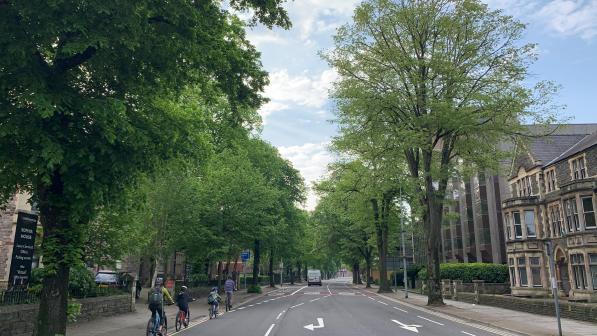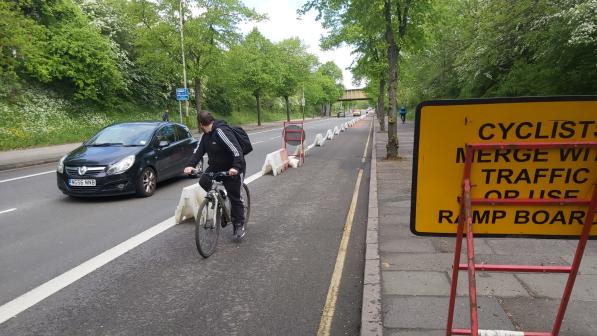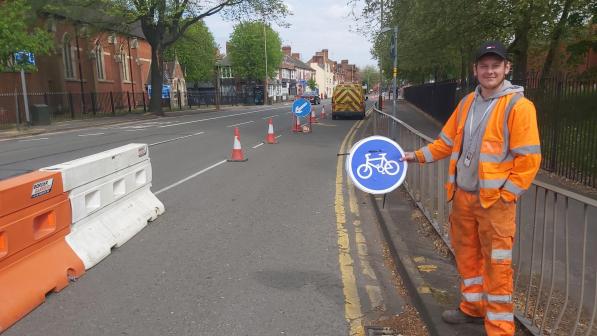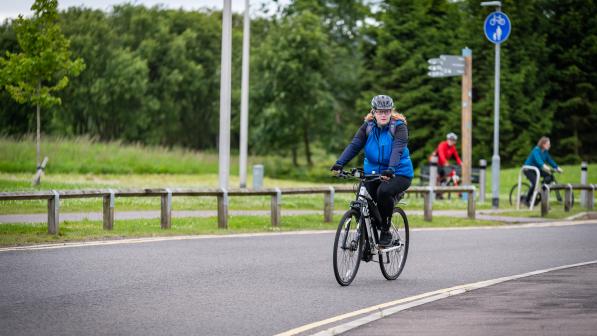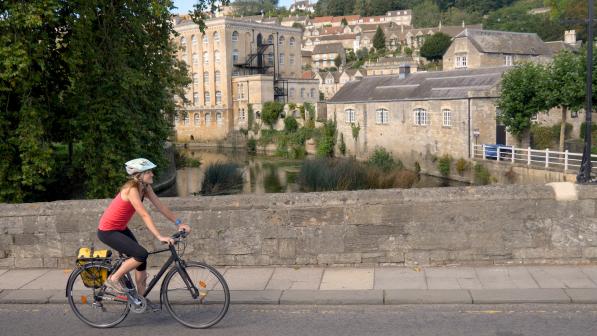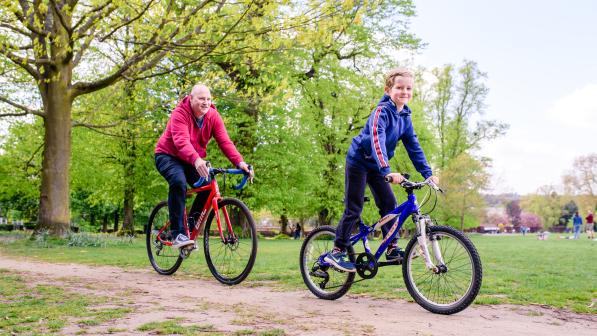Safe space for social distancing: FAQ

- What issues are you trying to solve?
- Which councils have the power to make the changes?
- Do local authorities really have time to deal with this now? Shouldn’t they be focussing on responding to the crisis?
- Can my individual councillor actually make these changes?
- I’ve sent the email on the action, but how can I get more involved?
- My councillor/council leader responded, but doesn’t appear to be interested. What should I do?
- Which cities or towns have implemented measures?
- I live in a rural area, is this relevant to me?
- Should people even be cycling right now – isn’t driving the best way to stay safe and self-isolate?
- The roads are much quieter than they were before the crisis, doesn’t this mean it’s safe enough to cycle without segregated space?
- Shouldn’t you be focussing on addressing speeding and dangerous drivers?
- I’ve seen cyclists failing to follow the rules on social distancing – shouldn’t you be addressing this?
- Won’t this just antagonise drivers?
- What about emergency service vehicles and those key workers who still choose to drive?
- Anything else?
Q. What issues are you trying to solve?
We want to ensure everyone is able to walk and cycle safely during the lockdown and as the lockdown restrictions are lifted, when we expect the roads and pavements will get much busier, but the social distancing requirements will remain.
Unfortunately, narrow pavements and a lack of segregated safe cycle lanes mean that this is currently difficult - we’ve all grown accustomed to seeing people having to walk out off the pavement and into the road to safely pass each other with 2m distance, while people cycling also need to move further out into the road to avoid passing others too closely. Equally, many cycle lanes which do exist, especially those lacking physical segregation which have only a painted line, are too narrow.
While we’re delighted to see many people, especially families, taking advantage of quieter roads to go out cycling, there has also been a rise in the proportion of cars speeding. We do believe that in some instances, converting one, or one part, of a lane of traffic for cycling will help everyone feel safe to cycle for essential journeys and exercise, including for key workers cycling to work to avoid the risk of infection posed by public transport.
Simple changes, such as using traffic cones and temporary traffic orders, can help make sure everyone is safe when they go out - and, just as importantly, will ensure they feel safe too.
Q. Which councils have the power to make the changes?
Upper tier local authorities in England are also Highways Authorities and have the necessary powers t make these changes (excluding trunk roads). In Scotland and Wales, there are only one tier of councils, and these are also responsible for the (non-trunk) roads. In Northern Ireland, the Department for Infrastructure is responsible for all roads.
We've therefore targetted our campaign at those councils which have the necessary powers, and all referenced to 'council' or 'councillor' in this campaign relate to these local authorities.
Q. Do local authorities really have time to deal with this now? Shouldn’t they be focussing on responding to the crisis?
We're very conscious of the fact that local authorities are very stretched - as they always are - and that's why we included a simple guide to help identify the things councils can do very quickly, easily and - best of all - cheaply.
We believe that ensuring people can travel safely during the lockdown, both in terms of social distancing and safe roads, is be a key part of councils’ response to the crisis, as part of their public health and safety responsibilities, and as part of their wider responsibilities as highways authorities.
Whether that enables people to get out for exercise, make essential journeys, or enable key workers to travel to and from work safely, safe space for cycling and walking is hugely important right now.
We’ve already seen cities and towns worldwide and in the UK take action so, while every local authority will have different resources, we don’t believe it is impossible or would negatively impact on the councils ability to deal with other aspects of the ongoing crisis.
Q. Can my individual councillor actually make these changes?
Councillors are influenced by the emails and letters they get from their constituents and the more they hear about an issue the more likely they are to discuss with their colleagues, help build up support within the local authority for such changes and lobby the relevant departments and members to secure this space for distancing.
Q. I’ve sent the email on the action, but how can I get more involved?
The best thing you can do is to speak to friends, family and colleagues to get them to take part too – the more people who write to their council, the more likely they are to listen.
You could also look to see if there’s a local cycling campaign which you could get involved in. You can either search on our website (filter by ‘campaigning group’) or just google [your town/city/county] followed by “cycling campaign group”.
If you’re in Scotland, you can also get involved in Pedal on Parliament’s social media action to demonstrate exactly where you’d think temporary space for cycling and walking would help keep people safe and moving.
If you want to do more but still aren’t sure how, get in touch.
Q. My councillor/council leader responded, but doesn’t appear to be interested. What should I do?
It may be worth engaging further with your councillor, especially if any of their responses are covered in our guide for councils. You may also help convince them by giving them a specific example, such as extending the pavement where people are queueing up outside a supermarket near you, or providing a segregated cycle lane on a route to a hospital.
You could also try to highlight the importance of these measures for vulnerable people, especially if you or someone you know is currently struggling to leave the house for essential journeys because they don’t feel safe.
However, even if your individual councillor isn’t interested, don’t give up hope. The best thing you can do is encourage your friends, family members and colleagues to also take part in the action – as the more emails any individual councillor received, and the more emails which go to the council leader, the more likely they are to recognise how important this is to people.
Q. Which cities or towns have implemented measures?
The map below shows which local authority action's we've heard about:
The list is growing rapidly, so please let us know if you hear of anything happening locally to you, especially if you’re able to send us in a photograph.
Q. I live in a rural area, is this relevant to me?
Even outside towns and cities, councils can make interventions to help keep everyone safe. This could include temporary traffic calming measures in villages, to stop people speeding, or warning signs on country roads to remind drivers to be careful of pedestrians and cyclists, especially as people will be walking and cycling from their front door, so may need to use country roads to access footpaths, bridleways or trails.
Equally, most council areas will have at least one reasonably large town where measures could help keep people safe and help key workers get to and from work, so just because it may not directly affect the area around where you live, it is important that your local authority knows this is important to you.
Q. Should people even be cycling right now – isn’t driving the best way to stay safe and self-isolate?
The World Health Organisation has said that during this crisis people should walk or cycle wherever feasible as opposed to driving to help keep fit, which is important for the immune system. Cycling and walking will also help keep people productive and are two of the easiest way for people to get their daily exercise.
We also know thousands of NHS and key workers are cycling to work to avoid the infection risk of public transport. It is crucial that those people are able to do so safely.
Q. The roads are much quieter than they were before the crisis, doesn’t this mean it’s safe enough to cycle without segregated space?
Although roads are quieter and that means there are more people out cycling, unfortunately some drivers are taking advantage of quiet roads and speeding.
Converting spare road capacity for cycling and walking will help ensure everyone feels safe to travel by foot or bike at this time, including the thousands of key workers travelling by bike to avoid the infection risk of public transport
Equally, given the request that people exercise from their front door, it’s important that families can get out on their bike and feel safe, even if they have to use some busier roads.
What’s more, the current situation makes it difficult for people to get out without breaching the social distancing guidelines, especially for pedestrians. Many pavements are less than 2m, so this space isn’t just needed from a road safety point of view, but also to ensure people can keep moving without risking infection.
Q. Shouldn’t you be focussing on addressing speeding and dangerous drivers?
We have linked up with other road safety charities to put out a call for people to drive more carefully and slowly, but the reality is that the most effective way to quickly tackle speeding on roads, especially in towns and cities, is by reducing the road space for cars.
This will be effective at reducing their speed to a safe level, while it shouldn't cause any significant congestion for key workers or emergency vehicles, given how little traffic is on the road.
This means more space for cycling and walking will actually be keeping everyone who uses the roads safer, including key workers.
Q. I’ve seen cyclists failing to follow the rules on social distancing – shouldn’t you be addressing this?
We've provided a huge amount of information to help cyclists continue riding safely while following social distancing guidelines.
While there have been some press reports relating to cyclists not following social distancing rules, some of these have unfortunately been deliberately misleading and we have issued a press complaint in respect of this. We haven’t seen any evidence suggesting that cyclists are obeying the social distancing rules less than other people.
What we do know is that many of the traditionally routes which are segregated from traffic and therefore feel safest for cyclists – including segregated cycle lanes, canal towpath and shared walking and cycling routes - are currently too narrow to allow for people to socially distance easily. We have produced a guide to help people social distance when using these routes, but the reality is that more space is needed.
As such, the best way to help everyone social distance is to ensure that sufficient space is provided to cyclists and pedestrians.
Q. Won’t this just antagonise drivers?
This isn't about being anti-car - it's about recognising how things have changed over the past few weeks and keeping people safe.
With the huge drop in congestion, coupled with the increase in people's travelling being very locally focussed, we think that measures to transfer some space to cycling and walking are sensible and achievable, and shouldn't have any negative impact on emergency service vehicles or key workers who have to continue driving.
Q. What about emergency service vehicles and those key workers who still choose to drive?
Given the huge drop in congestion we’ve seen over the past few weeks, the measures we’re suggesting shouldn’t have a negative impact on those people who still need to drive for essential journeys or to get to work.
However, reducing road space for motor vehicles will help tackle the growth in speeding, and in doing so help keep all road users safer, including emergency vehicles drivers and key workers.
As the lockdown eases, it's also vital that people feel enabled to cycle and walk, as this will help reduce congestion for key workers who choose to drive and for emergency vehicles. Given people are likely to avoid public transport where possible, if everyone tried to use their car, this will create unprecedented levels of congestion, damaging the economic recovery and leaving key workers facing difficulties getting to work.
Anything else?
If you have a question we haven't answered, please do get in touch.
